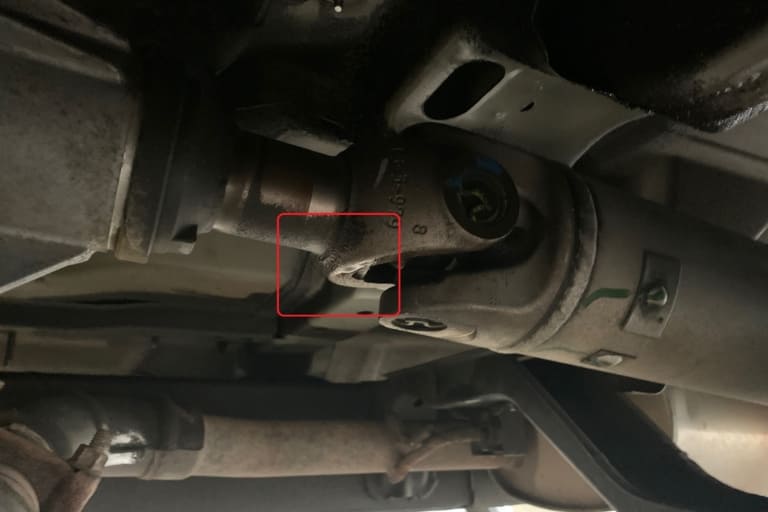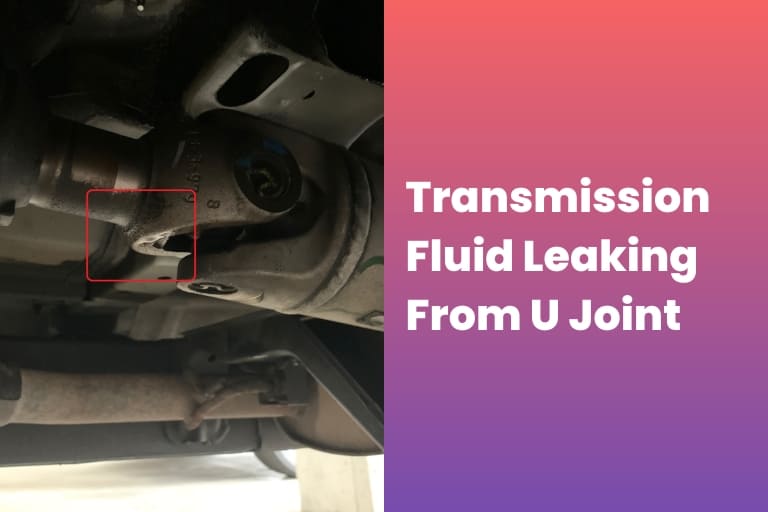Transmission fluid is a lubricant used in vehicles to lubricate, calm, and clean the transmission and torque converter. It helps ensure the transmission’s smooth operation and prevents wear and tear on the gears and other internal parts. It also helps transfer power from the engine to the transmission and can act as a sealant to prevent leaks.
A transmission fluid leak can present several symptoms, some of which include low fluid levels, a burning smell, difficulty shifting gears, slipping gears, grinding or strange noises coming from the transmission, a Tranmission fluid warning light on the dashboard, an overheating transmission, decreased fuel efficiency and leaking fluid under the vehicle.
Contents
What Is a U-Joint, and What Is the Role of A U Joint in The Vehicle?
A universal joint, or u-joint, is a mechanical component in a vehicle that connects the drive shaft to the differential, allowing power to be transferred from the transmission to the drive wheels.
It allows for flexibility in the drive shaft, which is necessary for the wheels to move up and down with the road surface while the drive shaft remains in a constant position.
The u-joint also allows for slight misalignments between the transmission and differential, which can occur due to suspension movement and other factors. Without a u-joint, the drive shaft would be unable to accommodate these misalignments and would likely break.
Possible Causes of Transmission Fluid Leaking From U Joint

There are several possible causes for a transmission fluid leak from a u-joint, including:
- Hole in the yoke: A hole in the yoke can allow transmission fluid to leak out because the hole would be opening for the fluid to escape. The hole can be caused by rust, corrosion or impact damage.
- Worn splines on the driveshaft yoke: Worn splines can cause the u-joint to fail and allow transmission fluid to leak out. The splines are the ridges that help the u-joint to hold in place. If these wear out, the u-joint will not be securely stored, and the transmission fluid can escape.
- A loose or faulty seal: A u-joint seal is a small rubber ring that sits between the yoke and the driveshaft. It prevents transmission fluid from leaking out. If the seal is loose or faulty, it will not be able to contain the fluid, and it will leak out.
- Improper installation: If the u-joint is not installed correctly, it can cause leaks and other issues with the transmission. The u-joint must be installed in the correct position and orientation, and the seals and caps must be appropriately secured. If the installation is not done properly, it can also cause the u-joint to fail and leak transmission fluid.
How to Repair Transmission Fluid Leaking From U Joint?
There are several methods for repairing a transmission fluid leaking from u joint, including:
- Sealing the leak: If the leak is small and localized, it may be possible to seal it using a transmission fluid leak sealant. This is a temporary solution and should be used as a stop-gap measure.
- Replacing the u-joint: If the u-joint is worn or damaged, it may need to be replaced. This involves removing the old u-joint and installing a new one. This is a more permanent solution and can help to prevent further leaks.
- Replacing the seal: If the seal is loose or faulty, it can be replaced with a new one. This can help to prevent further leaks and maintain the integrity of the transmission system.
- Combination of both: A combination of the above methods may be used to repair the transmission fluid leak. For example, if the seal is worn and the u-joint is damaged. The seal and the u-joint will need to be replaced to fix the leak.
It is always best to have a professional mechanic diagnose and repair a transmission fluid leak. They have the tools and knowledge to diagnose the problem and make the necessary repairs properly.
Pros and Cons of Repairing Transmission Fluid Leakage
Everything on this earth has both advantages and disadvantages. So, in-depth, let us go through the pros and cons of the Transmission Fluid Leakage Repair Methods to determine which approach is the best and has the fewest constraints.
Sealing the leak:
| Pros | Cons |
|---|---|
| Sealing the leak is relatively inexpensive and can be done quickly. | It may not be a permanent solution, and the leak may reappear. |
| It can be a temporary solution for small leaks. | If a more significant problem causes the leak, sealing it will not address the underlying issue. |
Replacing the u-joint:
| Pros | Cons |
|---|---|
| Replacing the u-joint can be a more permanent solution to a transmission fluid leak. | Replacing the u-joint can be a more complex and time-consuming repair. |
| It can help prevent further leaks and ensure proper transmission system operation. | It can also be more expensive than other methods, requiring purchasing a new u-joint. |
Replacing the seal:
| Pros | Cons |
|---|---|
| Replacing the seal is relatively inexpensive and straightforward. | If the seal is damaged due to wear and tear, the u-joint may also be worn and need replacement. |
| It can help to prevent further leaks and maintain the integrity of the transmission system. |
Combination of both:
| Pros | Cons |
|---|---|
| It can fix the transmission fluid leak and address the underlying issue. | It may be more difficult and time-consuming to fix. |
| It can ensure the proper operation of the transmission system. | It can also be more expensive than other procedures because it necessitates the purchase of a new u-joint and seal. |
The cost and difficulty of the repair will depend on the cause of the transmission fluid leak and the method used to repair it. It’s always best to get a professional opinion and estimate the cost before making any decisions.
Prevention and Maintenance
Here are some tips for preventing transmission fluid leaks:
- Regularly check and maintain the U-Joint: Check the u-joint often, especially if you hear or feel unusual vibrations. Examine the u-joint for evidence of wear, corrosion, or leakage. Lubricate the u-joint with the proper type of transmission fluid.
- Regularly check and maintain the seals: Check the seals around the u-joint for wear or damage. Inspect the seals regularly, mainly if leaks or low transmission fluid levels exist. Use the suitable transmission fluid and keep the fluid level at the proper level.
- Properly maintain the transmission cooler: Maintain the cleanliness of the transmission cooler. Examine the transmission cooler lines for any leakage. If the transmission cooler becomes clogged or damaged, it must be replaced.
- Regularly check and maintain the drive shaft: Examine the drive shaft for evidence of wear, corrosion, or leakage. Check the drive shaft regularly, especially if you detect strange noises or vibrations. Keep the drive shaft greased with the proper lubricant.
- Always Check the temperature gauge: Check the temperature gauge. If the temperature is too high, it could indicate a problem with the transmission cooler or other issues.
By regularly checking and maintaining these components, you can help to prevent transmission fluid leaks and ensure proper operation of your transmission system.
It is also necessary to ensure you have regular servicing, maintenance and check-ups with professional mechanics. They have the proper tools and knowledge to diagnose any problem and ensure your Vehicle is in good shape.
Importance of Timely Maintenance
It is essential to address any transmission fluid leaks as soon as they are detected, to prevent further damage to the Vehicle. Transmission fluid is essential to the operation of the transmission system, and a shortage of fluid can cause significant damage to the transmission and other components.
If a transmission fluid leak is not repaired promptly, it can lead to several problems, including:
- Reduced transmission performance: A lack of transmission fluid can cause the transmission to slip, reducing performance and fuel efficiency.
- Increased wear and tear: A lack of fluid can cause increased wear and tear on the transmission components, leading to costly repairs or replacement.
- Overheating: A lack of fluid can cause the transmission to overheat, damaging the transmission and other components.
- Failure of the transmission: If a transmission fluid leak is not repaired, it can lead to complete loss of the transmission system.
- Reduced safety: If the transmission fails while driving, it can lead to a loss of power, which can be dangerous, especially when driving at high speeds or on the highway.
By addressing transmission fluid leaks promptly, you can help to prevent further damage to the Vehicle and ensure that it continues to operate safely and efficiently.
Also Read:
- How to Change Transmission Fluid Like a Pro
- Transmission Fluid Leak when Parked on An Incline
- Transmission vs Differential Fluid
- Is a Transmission Fluid Leak Covered Under Warranty
- Can You Add Transmission Fluid While the Car Is Off
- Water in Transmission Fluid: Symptoms & Solutions
- How Long Should I Drive Before Checking the Transmission Fluid
- Transmission Fluid vs Brake Fluid: What’s the Difference
- Choosing the Right Fluid: Transmission Fluid vs Coolant
- How to Flush Transmission Fluid from The Radiator
- Problems After Transmission Fluid Change: Causes & Solutions
- Mistakenly Put Transmission Fluid in The Oil: Is There Any Fix
- Can You Lose Transmission Fluid Without A Leak
Conclusion
We can conclude that a transmission fluid leaking from U joint can be caused by various factors, including a hole in the yoke, worn splines on the driveshaft yoke, a loose or faulty seal, or improper installation. There are several methods for repairing a transmission fluid leak from a u-joint, including sealing the leak, replacing the u-joint, replacing the seal, or a combination of both.
Each method has its own set of pros and cons, and the cost and difficulty of the repair will depend on the cause of the leak and the technique used to repair it. To prevent transmission fluid leaks, it is essential to regularly check and maintain the u-joint and seals, properly maintain the transmission cooler, periodically check and maintain the drive shaft, and keep an eye on the temperature gauge.
Timely repairs are crucial in preventing further damage to the Vehicle, and it is always best to have a professional mechanic diagnose and repair any transmission fluid leaks.
